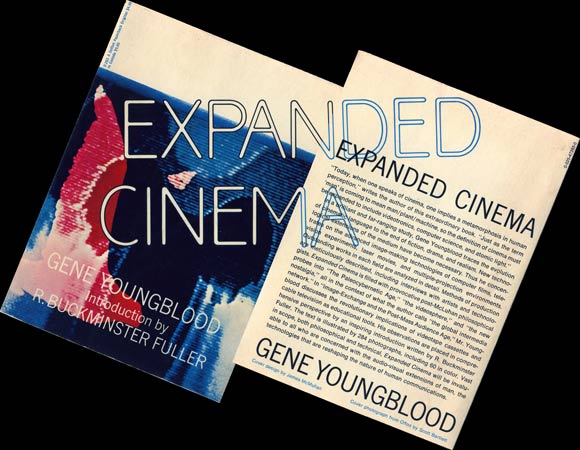Gene Youngblood: Expanded Cinema (1970)
Filed under book | Tags: · art, art history, computer film, computing, cybernetics, expanded cinema, experimental film, film theory, holography, intermedia, media art, multimedia, technology, television, video, video art

“The first book to consider video as an art form, was influential in establishing the field of media arts. In the book he argues that a new, expanded cinema is required for a new consciousness. He describes various types of filmmaking utilising new technology, including film special effects, computer art, video art, multi-media environments and holography.” (Wikipedia)
Part One: The Audience and the Myth of Entertainment
Part Two: Synaesthetic Cinema: The End of Drama
Part Three: Toward Cosmic Consciousness
Part Four: Cybernetic Cinema and Computer Films
Part Five: Television as a Creative Medium
Part Six: Intermedia
Part Seven: Holographic Cinema: A New World
Key words and phrases: Jordan Belson, expanded cinema, Nam June Paik, Buckminster Fuller, Stan VanDerBeek, videotronic, Ronald Nameth, Carolee Schneemann, John McHale, Expo 67, slit-scan, John Cage, light pen, Gene Youngblood, Otto Piene, Beflix, Howard Wise, KQED, Samadhi, WGBH-TV
Introduction by R. Buckminster Fuller
Publisher E.P. Dutton, New York, 1970
SBN 0525101527
432 pages
Reviews: Paul Cowen (Leonardo, 1972), Thomas Beard (Artforum, 2020), Caroline A. Jones (Artforum, 2020).
Analysis: Adam Sindre Johnson (2010, NO).
PDF (45 MB, no OCR, via Internet Archive, added on 2016-3-2)
PDF, PDF, PDF (5 MB, OCR)
PDF chapters
Armin Medosch: Technological Determinism in Media Art (2005)
Filed under thesis | Tags: · art, art criticism, critique, media art, technology, technoscience
“Technological determinism is the belief that science and technology are autonomous and the main force for change in society. It is neither new nor particularly original but has become an immensely powerful and largely orthodox view of the nature of social change in highly industrialised societies. In this paper I analyse the presence of technological determinism in general discourses about the relationship between social change and science and technology.
I show that techno-determinist assumptions underlie developments in what is called technoscience, a term describing new practices in science and technology with particular relevancy for the related fields of genetic engineering and computer science. Those areas create a specific set of narratives, images and myths, which is called the techno-imaginary. The thesis of my paper is that the discourse on media art uncritically relies on many elements of the techno-imaginary. A specific type of media art, which is identifiable with people, institutions and a period in time, is particularly engaged with the tropes of the techno-imaginary. This strand, which I call high media art, successfully engaged in institution building by using techno-determinist language. It achieved its goals but was short lived, because it was built on false theoretical premises. It made wrong predictions about the future of a ‘telematic society’ and a ‘telematic consciousness’; and it missed the chance to build the foundations of a theory of media art because it was and is contaminated by the false assumptions behind technological determinism.”
Keywords: technological determinism; media art; techno-utopianism; artificial intelligence; artificial life; cybernetics; art; progress; critical theory
Master’s thesis
Ravensbourne College / Sussex University
57 pages
PDF, PDF (updated on 2015-7-23)
Comment (0)Catherine Elwes: Video Art: A Guided Tour (2005)
Filed under book | Tags: · art history, media art, video, video art
/cover.jpg)
“Video art dominates the international art world to such an extent that its heady days on the radical fringes are sometimes overlooked–often unknown. This book is an essential and highly entertaining guide to video art and its history. Elwes, herself a pioneer of early video, traces the story from the weighty Portapak equipment of the ’60s and ’70s to today’s digital technology, from early experiments in “real time” to the “new narrative” movement of the 1980s. She also examines video’s love-hate relationship with television, from its literal destruction in “scratch” video to its apparent absorption into the mainstream with works commissioned by Channel Four. Throughout its forty-year history, video has been allied to self-portraiture, landscape, painting and sculpture and has been co-opted as a political tool. Artists discussed include amongst many others Nam June Paik, Nan Hoover, The Duvet Brothers, Dara Birnbaum, Bill Viola, Pipilloti Rist, David Hall, Stuart Marshall, Shirin Neshat, Smith & Stewart, Steve McQueen and Sam Taylor-Wood.”
Publisher I.B.Tauris, 2005
ISBN 1850435464, 9781850435464
x+212 pages
PDF (updated on 2022-7-23)
Comment (1)
